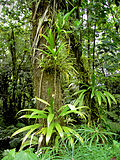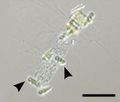Epiphyte
Epiphyte is a type of plant that grows on another plant, but unlike parasites, epiphytes derive their moisture and nutrients from the air, rain, and sometimes from debris accumulating around it. Epiphytes are not directly harmful to the plants they grow on. They are found in the temperate zone (e.g., many mosses, liverworts, lichens, and algae) and in the tropics (e.g., many ferns, cacti, orchids, and bromeliads).
Characteristics[edit]
Epiphytes are characterized by their ability to grow on other plants for physical support. They are not rooted in soil and do not take nutrients from their host plants. Instead, they have specialized structures for obtaining water and nutrients from the air and rain. Some epiphytes have roots that cling to the host plant, while others have structures called holdfasts that grip the host.
Types of Epiphytes[edit]
There are several types of epiphytes, including:
- Bromeliads: These are a family of monocot flowering plants native to the tropical Americas. Many bromeliads are able to store water in a structure formed by their tightly-overlapping leaf bases.
- Orchids: Orchids are a diverse and widespread family of flowering plants, with blooms that are often colorful and fragrant. Many orchids are epiphytes, particularly those native to tropical regions.
- Ferns: Some ferns are epiphytes, growing on the surface of other plants. They are particularly common in tropical rainforests.
- Mosses: Mosses are small, non-vascular plants that typically form dense green clumps or mats, often in damp or shady locations. Some mosses are epiphytes, growing on the bark of trees.
- Lichens: Lichens are composite organisms consisting of a fungus and a photosynthetic partner growing together in a symbiotic relationship. Many lichens are epiphytes.
Ecological Importance[edit]
Epiphytes play an important role in the ecosystem. They provide food and habitat for a variety of animals. In tropical rainforests, epiphytes provide a significant proportion of the canopy foliage and are important for the cycling of nutrients within the forest.
See Also[edit]
Ad. Transform your life with W8MD's Budget GLP-1 injections from $75


W8MD offers a medical weight loss program to lose weight in Philadelphia. Our physician-supervised medical weight loss provides:
- Weight loss injections in NYC (generic and brand names):
- Zepbound / Mounjaro, Wegovy / Ozempic, Saxenda
- Most insurances accepted or discounted self-pay rates. We will obtain insurance prior authorizations if needed.
- Generic GLP1 weight loss injections from $75 for the starting dose.
- Also offer prescription weight loss medications including Phentermine, Qsymia, Diethylpropion, Contrave etc.
NYC weight loss doctor appointmentsNYC weight loss doctor appointments
Start your NYC weight loss journey today at our NYC medical weight loss and Philadelphia medical weight loss clinics.
- Call 718-946-5500 to lose weight in NYC or for medical weight loss in Philadelphia 215-676-2334.
- Tags:NYC medical weight loss, Philadelphia lose weight Zepbound NYC, Budget GLP1 weight loss injections, Wegovy Philadelphia, Wegovy NYC, Philadelphia medical weight loss, Brookly weight loss and Wegovy NYC
|
WikiMD's Wellness Encyclopedia |
| Let Food Be Thy Medicine Medicine Thy Food - Hippocrates |
Medical Disclaimer: WikiMD is not a substitute for professional medical advice. The information on WikiMD is provided as an information resource only, may be incorrect, outdated or misleading, and is not to be used or relied on for any diagnostic or treatment purposes. Please consult your health care provider before making any healthcare decisions or for guidance about a specific medical condition. WikiMD expressly disclaims responsibility, and shall have no liability, for any damages, loss, injury, or liability whatsoever suffered as a result of your reliance on the information contained in this site. By visiting this site you agree to the foregoing terms and conditions, which may from time to time be changed or supplemented by WikiMD. If you do not agree to the foregoing terms and conditions, you should not enter or use this site. See full disclaimer.
Credits:Most images are courtesy of Wikimedia commons, and templates, categories Wikipedia, licensed under CC BY SA or similar.
Translate this page: - East Asian
中文,
日本,
한국어,
South Asian
हिन्दी,
தமிழ்,
తెలుగు,
Urdu,
ಕನ್ನಡ,
Southeast Asian
Indonesian,
Vietnamese,
Thai,
မြန်မာဘာသာ,
বাংলা
European
español,
Deutsch,
français,
Greek,
português do Brasil,
polski,
română,
русский,
Nederlands,
norsk,
svenska,
suomi,
Italian
Middle Eastern & African
عربى,
Turkish,
Persian,
Hebrew,
Afrikaans,
isiZulu,
Kiswahili,
Other
Bulgarian,
Hungarian,
Czech,
Swedish,
മലയാളം,
मराठी,
ਪੰਜਾਬੀ,
ગુજરાતી,
Portuguese,
Ukrainian











